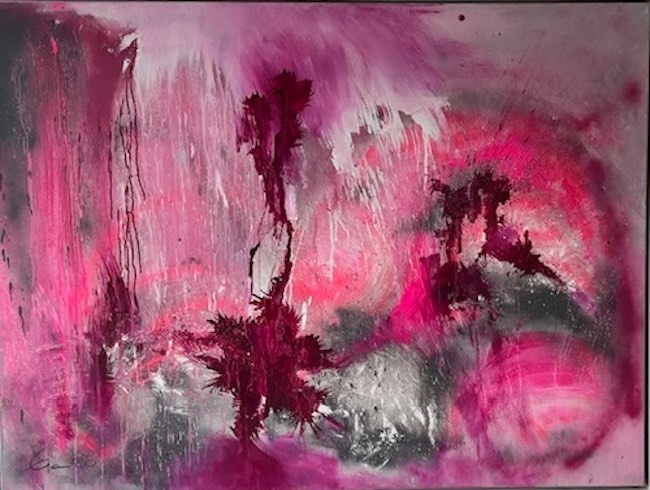Il mondo interiore dell’artista ha talvolta bisogno di manifestarsi in maniera immediata e impulsiva, come se uno stile pittorico troppo definito limitasse il libero fluire delle emozioni, come se la parte razionale chiamata a dare una maggiore definizione dell’osservato, fosse in qualche modo un limite intollerabile a una creatività che necessita di non avere alcun tipo di condizionamento formale. La scelta dunque di un approccio pittorico informale diviene essenziale per riuscire a realizzare con pienezza la propria identità espressiva, proprio perché nel caso di questi artisti l’irrazionalità deve essere preponderante per mantenere il contatto con il proprio io interiore e anche per essere in grado di trasmettere sulla tela le medesime vibrazioni emotive che di conseguenza raggiungono in modo immediato l’osservatore. La protagonista di oggi non solo sceglie uno stile assolutamente istintivo e diretto ma usa un solo colore, il rosa, declinato in mille sfumature e sfaccettato tanto quanto lo sono i suoi frammenti di pensieri o di emozioni che di opera in opera desidera emergano.
Gli anni Quaranta del Novecento furono contraddistinti da molte rivoluzioni artistiche poiché il periodo di completa ribellione e di distacco dalle tradizioni accademiche stava cominciando ad affievolirsi e gli artisti sentivano la necessità di affrancarsi dalle rigide regole dei movimenti di inizio secolo, o in altri casi di approfondirne le linee guida e di trovare un modo per superarne gli ostacoli che avevano provocato una stagnazione del diffondersi di quegli stili. In particolare l’Arte Astratta era andata verso un allontanamento completo dall’emozionalità e dalla soggettività dell’autore dell’opera perché il suo scopo preponderante, se si esclude l’intento iniziale del suo fondatore, Vassily Kandinsky, era dimostrare la supremazia del gesto plastico da ogni influenza del visibile ma anche delle sensazioni; la pura bellezza andava oltre ogni riferimento riconducibile al soggetto perciò l’esecuzione artistica doveva essere spogliata da tutto quell’apparato formale ed emozionale che l’avrebbe inquinata. Dunque il De Stijl, il Suprematismo, l’Astrattismo Geometrico, si proposero di effettuare un’analisi scientifica sulla proporzione, sull’utilizzo dei colori primari o sulla geometricità inducendo l’osservatore a perdere ogni riferimento per calarsi nella contemplazione dell’incomprensibile, di qualcosa che lo distaccava da tutto ciò che era abituato a vedere ogni giorno. Questo tipo di atteggiamento espressivo mancava però di quel coinvolgimento di cui l’essere umano, e in particolar modo l’artista, ha bisogno per esprimere se stesso e fu esattamente in quel momento che cominciò a delinearsi negli Stati Uniti, un movimento in cui non esistevano più geometricità e confini espressivi e che lasciava i suoi interpreti liberi di scegliere lo stile più affine alla propria interiorità, ponendo come unica condizione quella di recuperare quel profondo contatto con l’interiorità in grado di infondere forza e incisivo impatto alla tela. L’Espressionismo Astratto, questo il nome della corrente fondata da Jackson Pollock, era pura emozione e strutturava il suo impianto creativo sulla mancanza di regole e anche sull’introduzione di una nuova dimensione all’interno del gesto creativo, e cioè l’azione; l’Action Painting e il Dripping erano manifestazioni istintive, completamente catartiche dal punto di vista dell’autore dell’opera ma anche per il pubblico che spesso assisteva alle perfomance di Pollock, solo per citare il più noto tra gli interpreti di questo stile, e che si trovava magnetizzato dai gesti dell’artista e assolutamente coinvolto in quel senso di liberazione interiore. L’artista austriaca Ela Reitinger è una perfetta rappresentante contemporanea dell’Action Painting e del Dripping, grazie anche ai corsi di formazione effettuati presso l’atelier del performer austriaco Hermann Nitsch; in lei però il mondo interiore viene rappresentato da un unico colore, quello che più la rappresenta e che descrive il suo approccio alla vita e lo sguardo sul mondo che la circonda, il rosa.
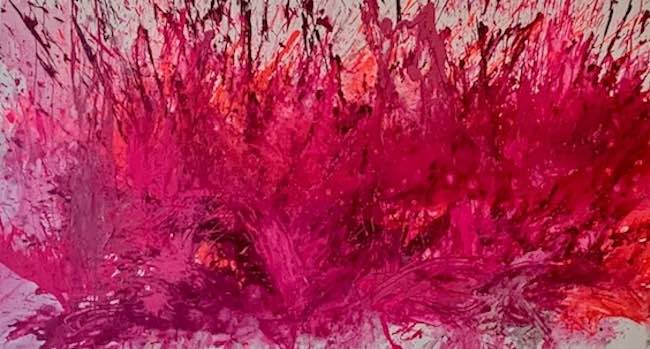
La capacità di mostrare ogni singola sfaccettatura di questa tonalità conquista l’osservatore al punto di abbandonare tutte le resistenze nei confronti di una gradazione cromatica abitualmente attribuita al mondo femminile, lasciandosi avvolgere dalla sua positività, dalla piacevolezza e dall’entusiasmante interpretazione che Ela Reitinger di volta in volta concretizza sulla tela; ciò che sorprende è in qualche modo l’allontanamento dalle emozioni più cupe, tormentate, per entrare in una dimensione in cui ogni accezione, ogni istintualità o reazione agli avvenimenti, si trasforma in filtro positivo, coinvolgente proprio perché tendente a considerare il lato più bello che emerge anche dalle emozioni meno piacevoli ma tuttavia parte dell’esistenza stessa.
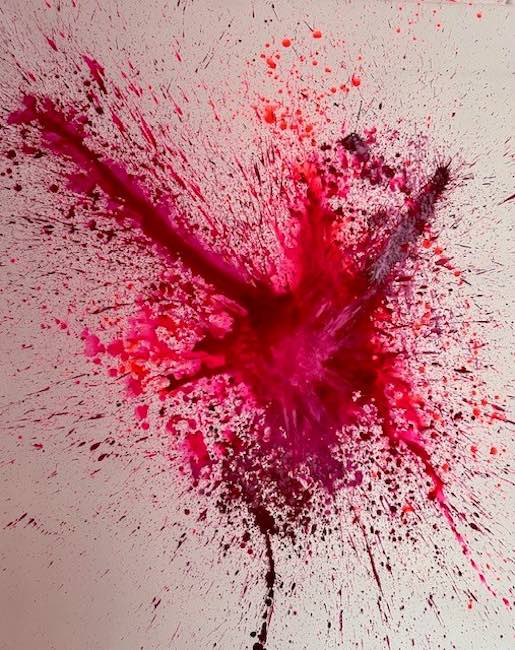
L’invito dell’artista è pertanto quello di aprirsi a tutto il mondo interiore, accettarne ogni aspetto, e lasciare con fiducia che le sensazioni fluiscano fuori fino al punto di generare una liberazione, un risanamento nei confronti persino di un’afflizione, dopo il quale è possibile tornare a sorridere in virtù della presa di coscienza e di una nuova consapevolezza della propria forza; ecco quindi che l’Action Painting diviene essenziale perché è esattamente all’interno di quel processo purificatorio che tutti i sensi vengono coinvolti, che la terza dimensione, lo spazio, entra a far parte del gesto creativo immettendo nell’opera l’universo più profondo che ha bisogno di uscire, dopo aver accettato anche le sue ombre.
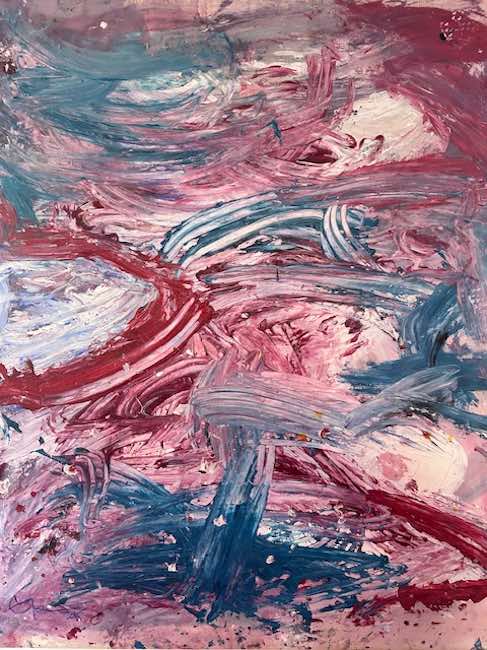
La connessione tra il sentire di Ela Reitinger e l’approccio nei confronti del mondo che la circonda è dunque intensa e imprescindibile, costituisce la sua essenza personale quanto artistica e va a costituire il fondamento della sua espressività pittorica, mostrando al fruitore il suo punto di vista su qualsiasi sensazione che ha bisogno di manifestare.

L’opera Blob rappresenta in pieno l’identità pittorica di Ela Reitinger poiché associa perfettamente il colore rosa, con diverse sfaccettature di tonalità, all’Action Painting e al Dripping, come se l’istintualità della narrazione della macchia fosse necessaria per indurre l’osservatore a lasciarsi coinvolgere da quella massa informe dentro la quale immergersi per trovare se stesso, per meditare e abbandonarsi al benessere generato dalla gamma cromatica che contraddistingue l’artista. In questo caso lo sfondo sembra accogliere l’irruenza e la preponderanza del colore, divenendo perciò contenitore dell’emozione emanata dall’autrice e poi impressa sulla tela per permettere a chiunque ne fruisca di trarne il proprio personale messaggio, la propria intima traduzione emozionale. Anche quando posa lo sguardo sulla realtà circostante, sui paesaggi, trasformandoli in luogo ideale e immaginario modificato dalla lente attraverso cui osserva e sente tutto ciò che le ruota intorno, Ela Reitinger non riesce fare a meno di filtrare tutto con il rosa, la tonalità che fa vibrare l’anima, che propaga la sua energia e va scuotere quelle parti dell’interiorità spesso tenute nascoste perché ritenute fragili, ma che possono essere rafforzate e comprese solo nel momento in cui vengono manifestate, o forse sarebbe meglio dire affrontate.
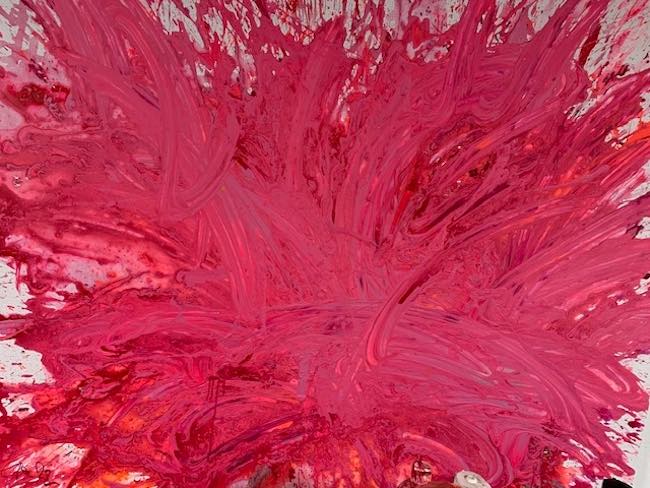
Da questo punto di vista la Reitinger ha già dialogato con la sua anima, è perfettamente in equilibrio con se stessa e sceglie di divenire messaggera di armonia e di positività attraverso la sua pittura; questo perfetto bilanciamento emerge in maniera forte e intensa in Rosa Rosé dove l’iniziale esecuzione impulsiva si mescola a un’ulteriore intervento dell’artista con il pennello come se in qualche modo volesse sottolineare l’importanza di un attento ascolto nei confronti di tutto ciò che potrebbe essere destabilizzante e poi ricostituire un equilibrio necessario riprendendo in mano la gestione delle sensazioni appena liberate, come se successivamente all’azione fosse necessaria una reazione in grado di condurre verso un’evoluzione più consapevole.
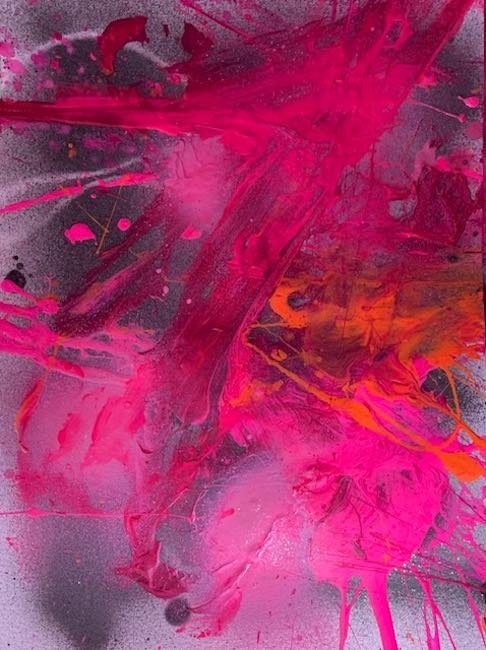
In Pink Energy invece tutto ciò su cui si sofferma Ela Reitinger è la bellezza plastica e rappresentativa del colore, quella contemplazione di una perfezione estetica generata esattamente dall’indefinitezza che è funzionale a mettere in evidenza l’assoluta perfezione di una semplice tonalità cromatica; qui la forza è dirompente, sembra esplodere sulla tela per raggiungere in maniera più diretta l’osservatore che viene attratto magneticamente da un’energia irrazionale eppure tangibile perché in grado di far vibrare corde che senza la comunicatività dell’azione pittorica dell’artista rimarrebbero ferme, imprigionate nella razionalità.
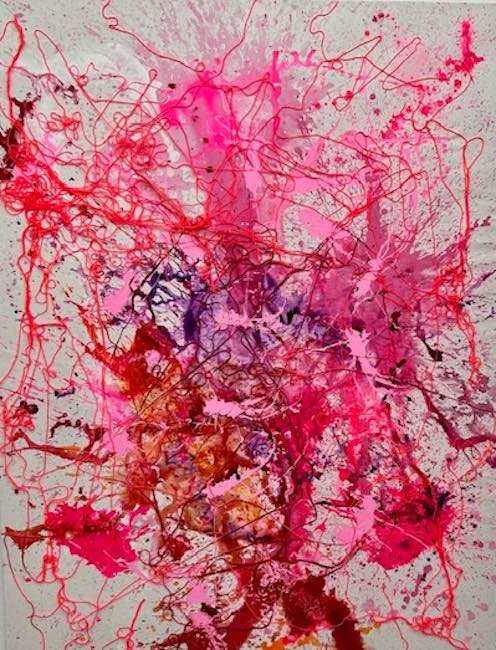
Ela Reitinger, che ha avuto una formazione accademica e che ha deciso di denominare il suo particolare stile come Pink Art, ha al suo attivo la partecipazione a molte mostre in Austria, Italia, Germania, Repubblica Ceca, Svizzera, Dubai, Washington DC, India, ricevendo apprezzamenti dal pubblico e dalla critica.
ELA REITINGER-CONTATTI
Email: elareit@yahoo.de
Sito web: www.elareitinger.com/
Facebook: www.facebook.com/ela.reitinger
Instagram: www.instagram.com/pink_art/
Life in pink with the overwhelming emotional explosion of Ela Reitinger’s Action Painting
The artist’s inner world sometimes needs to manifest itself in an immediate and impulsive manner, as if an overly defined pictorial style restricted the free flowing of emotions, as if the rational part called upon to give greater definition to the observed, were somehow an intolerable limit to a creativity that needs to have no formal conditioning. Therefore, the choice of an informal pictorial approach becomes essential to be able to fully realise one’s expressive identity, precisely because in the case of these artists, irrationality must be preponderant in order to maintain contact with one’s inner self and also to be able to transmit the same emotional vibrations on canvas that consequently reach the observer immediately. Today’s protagonist not only chooses an absolutely instinctive and direct style, but uses only one colour, pink, declined in a thousand shades and as multifaceted as are her fragments of thoughts or emotions that she wishes to emerge from artwork to artwork.
The Forties of Twentith Century were characterised by many artistic revolutions as the period of complete rebellion and detachment from academic traditions was beginning to fade and artists felt the need to break free from the rigid rules of the movements of the beginning of the century, or in other cases to deepen their guidelines and find a way to overcome the obstacles that had caused a stagnation in the spread of those styles. In particular, Abstract Art had moved towards a complete detachment from the emotionality and subjectivity of the author of the work because its preponderant aim, if we exclude the initial intent of its founder, Vassily Kandinsky, was to demonstrate the supremacy of the plastic gesture from every influence of the visible but also of sensations; pure beauty went beyond any reference attributable to the subject therefore the artistic execution had to be stripped of all that formal and emotional apparatus that would have polluted it. Hence De Stijl, Suprematism, Geometric Abstractionism, set out to effect a scientific analysis on proportion, on the use of primary colours or on geometricity, inducing the observer to lose all reference in order to immerse himself in the contemplation of the incomprehensible, of something that detached him from everything he was used to see every day. This type of expressive attitude, however, lacked the involvement that the human being, and especially the artist, needs to express himself, and it was precisely at that time that a movement began to take shape in the United States, in which geometricity and expressive boundaries no longer existed and which left its interpreters free to choose the style most akin to their own interiority, setting as the only condition that they recover the profound contact with interiority capable of infusing force and incisive impact to the canvas. Abstract Expressionism, this is the name of the current founded by Jackson Pollock, it was pure emotion and he structured his creative system on the lack of rules and also on the introduction of a new dimension within the creative gesture, namely action; Action Painting and Dripping were instinctive manifestations, completely cathartic from the point of view of the author of the artwork but also for the public who often attended Pollock‘s performances, just to mention the most famous of the interpreters of this style, and who found themselves magnetised by the artist’s gestures and absolutely involved in that sense of inner liberation.
The Austrian artist Ela Reitinger is a perfect contemporary representative of Action Painting and Dripping, thanks also to her training at the atelier of the Austrian performer Hermann Nitsch; in her, however, the inner world is represented by a single colour, the one that most represents her and describes her approach to life and her view of the world around: pink. The ability to show every single facet of this hue conquers the observer to the point of abandoning all resistance to a colour shade usually attributed to the feminine world, allowing oneself to be enveloped by its positivity, pleasantness and the exciting interpretation that Ela Reitinger from time to time brings to life on canvas; what is surprising is somehow the distancing from the darker, tormented emotions, to enter a dimension in which every meaning, every instinctuality or reaction to events, is transformed into a positive filter, involving precisely because it tends to consider the more beautiful side that emerges even from the less pleasant emotions but nevertheless part of existence itself. The artist’s invitation is therefore to open up to the entire inner world, to accept every aspect of it, and to trustingly let the sensations flow out to the point of generating a liberation, a healing towards even an affliction, after which it is possible to smile again by virtue of the realisation and a new awareness of one’s own strength; so Action Painting becomes essential because it is precisely within that purifying process that all the senses are involved, that the third dimension, the space, becomes part of the creative gesture, introducing into the painting the deepest universe that needs to come out, after having accepted its shadows as well.
The connection between Ela Reitinger‘s feeling and her approach to the world around her is therefore intense and inescapable; it constitutes her personal as much as artistic essence and is the foundation of her pictorial expressiveness, showing the viewer her point of view on any feeling she needs to manifest. The artwork Blob fully represents Ela Reitinger‘s pictorial identity as she perfectly associates the colour pink, with different facets of tonality, with Action Painting and Dripping, as if the instinctuality of the blob’s narration were necessary to induce the observer to allow himself to be involved by that formless mass within which to immerse himself in order to find, to meditate and abandon himself to the well-being generated by the artist’s chromatic range. In this case, the background seems to welcome the impetuosity and preponderance of colour, thus becoming a container for the emotion emanating from the artist and then impressed on the canvas to allow anyone who enjoys it to draw their own personal message, their own intimate emotional translation. Even when she sets her gaze on the surrounding reality, on the landscapes, transforming them into an ideal and imaginary place modified by the lens through which she observes and feels everything that revolves around her, Ela Reitinger cannot help but filter everything with pink, the tonality that makes the soul vibrate, that spreads its energy and shakes those parts of the interiority often kept hidden because they are considered fragile, but that can only be strengthened and understood when they are manifested, or perhaps it would be better to say faced.
From this point of view, Reitinger has already dialogued with her soul, is perfectly in balance with herself and chooses to become a messenger of harmony and positivity through her painting; this perfect balance emerges in a strong and intense manner in Rosa Rosé where the initial impulsive execution is mixed with a further intervention of the artist with the paintbrush as if in some way she wanted to emphasise the importance of careful listening to everything that could be destabilising and then reconstituting a necessary balance by taking back in hand the management of the sensations just released, as if after the action was necessary a reaction that could lead towards a more conscious evolution. In Pink Energy, on the other hand, all that Ela Reitinger dwells on is the plastic and representative beauty of colour, that contemplation of an aesthetic perfection generated precisely by the indefiniteness that is functional in highlighting the absolute perfection of a simple chromatic tone; here the force is disruptive, it seems to explode on the canvas to reach more directly the observer who is magnetically attracted by an irrational yet tangible energy because it is able to make vibrate chords that without the communicativeness of the artist’s pictorial action would remain still, imprisoned in rationality. Academically trained Ela Reitinger, who decided to name her particular style as Pink Art, has to her credit participated in many exhibitions in Austria, Italy, Germany, the Czech Republic, Switzerland, Dubai, Washington DC, and India, receiving public and critical acclaim.


